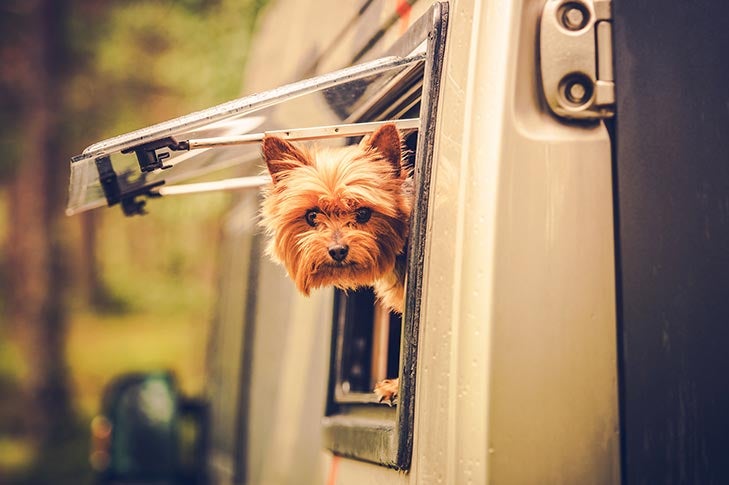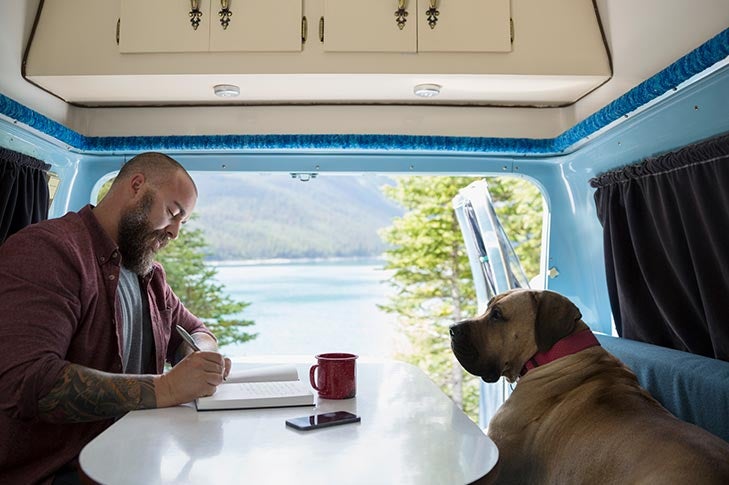
AKC is a participant in affiliate advertising programs designed to provide a means for sites to earn advertising fees by advertising and linking to akc.org. If you purchase a product through this article, we may receive a portion of the sale.
Road-tripping in an RV is a great way to include your dog in your vacation plans. But, for many people, RV travel is more than a break from the daily grind — it is their daily routine. People of all ages are turning to full-time RV living, and they’re bringing their pets along for the journey.
Full-time RVers aren’t the only ones logging a lot of road miles with their dogs. Faced with frequent cross-country travel for dog shows and athletic competitions, for instance, many dog owners find RV travel with dogs a much easier option than flying. Whether you’re living the nomadic lifestyle or frequently hitting the road with your pup out of necessity, keep reading for tips on how to keep your dog safe, happy, and healthy in your home on wheels.
Preparing For the Trip
Successful cross-country travel with dogs begins before you hit the road. Consider your dog’s needs regarding health, comfort, and safety as you plan your destinations and itinerary. Here is a list of things you should take care of before setting out.

Train Your Dog
“Teaching your dog the basic sit and stay commands and how to walk on a leash will be very helpful,” says Dr. Sara Ochoa, DVM, a veterinary consultant for Doglab. Make sure the leash and harness are a good fit and give your pup plenty of time to get used to them. While your dog should remain on leash any time you’re stopped, be sure they know how to come when called in case they get away from you.
Acclimate Them to RV Travel
“Condition your dog with positive reinforcement to love your camper van,” says dog behaviorist and trainer Russell Hartstein, CEO of Fun Paw Care. This also goes for your tow vehicle if you’ll be pulling your home instead of driving it.
Spend time just hanging out in the RV and allowing them to get used to the space before taking them for short spins around the block, using the same travel crate or seat–harness system you plan to use while traveling. Gradually increase the distance, giving your pooch plenty of praise and treats to make the experience fun.
See Your Vet For a Checkup
Make sure vaccinations are up-to-date and internal and external parasites are under control. Get current proof of the rabies vaccination and a certificate of health, which you may need to present at some facilities while traveling. This is a good time to talk to your vet about how to provide care for any chronic conditions while on the road and stock up on necessary medications.
Dr. Ochoa also recommends getting a copy of your dog’s health records to show any new vets you visit during your travels. This way, they will have a complete picture of your pet’s health history.

Get ID Tags and a Microchip
If you already have ID tags for your dog, make sure your contact information is current. Enrolling your pet with AKC Reunite can help your dog get returned to you more quickly if you become separated. It’s also a good idea to carry printed photos of your dog in case they get lost, rather than relying on digital photos in areas where you don’t know how reliable reception will be.
Prepare For Emergencies
Assemble a dog first-aid kit (or buy a pre-assembled one) for your RV. If you know where you’ll be going, search the area for the locations, names, and numbers of emergency vets and pet hospitals, then print them out and keep them with the kit.
If you’ll be camping out in remote areas, have a plan in place for how you’ll handle any injuries or health emergencies that arise. Hartstein also recommends keeping all of your dog’s safety gear in the same place as the first-aid kit so you’ll always know where to find everything you need.
Traveling With Your Dog
On travel days, your dog should ride secured in the same vehicle as you. If you’re towing your RV, never leave your dog to ride in the trailer, which could not only become too hot but also fill up with exhaust.
“Keep your dog in a kennel while traveling,” says Dr. Ochoa. “This is the best and safest way for them to travel. They will be safe in their kennel if you are in an accident or have to suddenly use your brakes.”

Be sure to make frequent stops to allow your dog to stretch their legs, relieve themselves, and drink plenty of water. Also remember to practice heat safety by never leaving your pup in a vehicle on a warm day without the A/C running, even with the windows down.
At Your Destination
Whether staying at a campground or dry-docking in the wilderness, follow these tips to keep your dog safe and feeling secure.
Keep Your Dog Leashed When Outside the RV
Not only is this both safer for your pet and considerate to your neighbors, but many campgrounds also require pets to stay on leash. Even if they don’t, the city or county you’re staying in may have leash laws that would prevent your dog from legally going off-leash outside designated areas, such as a dog park.
Keep the Air Conditioner or Heat on When Leaving Your Dog Unattended
If you’re staying in an area with a warm climate, have a backup system in place for keeping your dog cool in case of power failure or an A/C malfunction while you’re gone. Always leave the air vents open with the fans on and beware of newer ventilation fans with built-in sensors that automatically shut vents if it rains. If your RV has these sensors, disable them before leaving your dog alone in the RV. Also, be sure to set out plenty of water before you leave.
Give Dogs Their Own Space
“If there is enough room for a crate, then that could be a great spot for them,” says Hartstein. A spare bunk, or even a dog bed stashed under the dinette table, is a great spot where your pup can go to relax and feel safe.
Bring Comforts From Home
Providing your pet with a favorite blanket or toy will help them settle into your home away from home. And be sure to keep their favorite treats on hand for rewarding good behavior.

Clean Up After Your Pet
Again, cleaning up after your dog is not only considerate, but it’s also a requirement in most campgrounds. Even if you’re dry-docking in the wilderness, picking up after your pup is better for the environment and the surrounding wildlife.
Locate the Nearest Storm Shelter
Be sure your campground’s shelter allows pets, and keep a sharp eye on the weather reports, especially in areas prone to tornadoes or hurricanes.
Help Your Dog Be a Quiet Neighbor
If your companion is prone to barking at the slightest disturbance, try using a fan or white-noise machine to mask outside sounds. When you need to leave your dog alone, take them on a walk first to release any pent-up energy and tire them out. Leave plenty of toys to keep them from barking out of boredom. If that doesn’t curb out-of-control barking, try different techniques to discourage barking.

Bring the Right Gear
Besides your pet’s food, fresh water, bowls, leash, harness, grooming supplies, and all the comforts and necessities of daily life, think about activities you’ll want to engage in with your dog and pack accordingly. Here are some items you might want to bring along:
- Safety harness with a handle
- Light that attaches to a leash or collar
- Dog life vest
- Water toys
- Booties to protect paws in snow and ice or on hot or rocky surfaces
- Dog sunscreen for nose, ears, and other exposed areas
- Pet-friendly mosquito and tick repellent
- Collapsible food and water dishes for your backpack
- Sun goggles to protect your pet’s eyes
- Towels for drying your pup off, mopping up messes, or providing a surface to lie on
- Umbrella for shade
- Folding or collapsible playpen for small dogs
- Sweater or jacket for cold climates
As long as you take precautions, you and your dog will have a great time wherever your journeys take you. And we’ve got plenty more travel safety tips for dogs and owners on the go.


